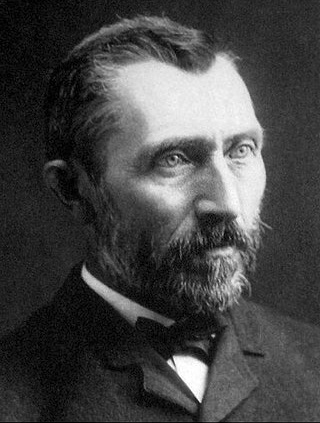Vincent van Gogh was born on March 30, 1853, in the hamlet of Zundert, which is located in the province of North Brabant in the south of the Netherlands. He died on July 29, 1890. The Reverend Theodorus van Gogh (1822–1885) and Anna Cornelia Carbentus (1819–1907) were Vincent’s parents. Among their other children were Vincent’s sisters Elisabeth, Anna, and Wil, as well as his brothers Theo and Cor. Vincent van Gogh was the eldest son of his parents. It is known very little about Vincent’s childhood other than the fact that he was a shy child who did not display any obvious artistic ability. He himself would eventually look back on his joyful upbringing with a great deal of satisfaction in later life.
Van Gogh’s Education / Work
Van Gogh got an education that was more piecemeal than comprehensive. He spent one year at the village school in Zundert, two years at a boarding school in Zevenbergen, and eighteen months at a high school in Tilburg. At the age of sixteen, he started working at the Hague gallery of the French art dealers Goupil et Cie, in which his uncle Vincent was a partner. He worked there until he was twenty-one. After him, his sibling Theo, who was born on May 1 of the same year, also worked for the same company. In 1873, Vincent was transferred to London by Goupil’s, and then two years later, he was transferred to Paris by the same company. It was in Paris that he gave up any desire to become an art trader. Instead, he immersed himself in religion, discarded his contemporary work that dealt with the outside world, and, in the words of his sister Elisabeth, became “daffy with piety.” Since he showed so little enthusiasm for his employment, he was let go at the beginning of the year 1876.
After that, Van Gogh moved to England to work as an assistant teacher there. However, by the end of the year, he was dissatisfied with the dearth of opportunities and returned to Holland. He ultimately made up his mind to pursue a career in the ministry like his paternal grandfather had done. Despite the fact that they were disturbed by their son’s fanaticism and odd behavior, his parents consented to pay for the private lessons that he would require in order to be accepted into the university. Another erroneous beginning resulted from this. Van Gogh eventually gave up on his studies and, after receiving some initial instruction as an evangelist, relocated to the Borinage coal-mining region in the southern region of Belgium. Because of his ministry among the mine workers, he was able to profoundly identify with the workers and their families. However, his appointment was not extended, and his parents, who considered him an outcast in society, became increasingly despondent. In an unguarded moment, his father even brought up the possibility of checking him into a psychiatric institution.
In 1886, he uprooted his life and relocated to Paris, where he settled in with his brother Theo, an art dealer who owned a modest gallery. He made fast friends with the young painters of the period, who were at the vanguard of the most progressive artistic movements at the time. Van Gogh’s approach started to change as he became exposed to the work of Japanese artists and other artists who worked in the impressionist tradition. His brushstrokes became more refined, and his colors became more vibrant, as they were influenced by the forms of the things he was depicting. Before moving from Paris to the south of France in 1888, he began using the bold and vivid colors that were common in the works of his contemporary French artists.
He painted landscapes and images of southern life while he was living in Provence, which was bathed in sunlight. The artist, who was based in Arles at the time, started using brushstrokes that were curved and swirling, in addition to using pure colors, especially yellow, green, and blue. Both of Van Gogh’s most renowned paintings, “Bedroom in Arles” (1888) and “The Starry Night,” feature this technique, which is very unique to Van Gogh’s body of work (1889). Any visible creation made by Van Gogh during this time period, whether it be a painting or a drawing, appears to be endowed with a physical and mental vitality. Because of his infectious enthusiasm, he was able to convince Paul Gauguin, an artist whom he had previously encountered in Paris, to come stay with him.
After working together for less than two months, their relationship quickly deteriorated, culminating in the legendary dispute in which Van Gogh threatened Gaugin with a razor blade. In the same evening, Van Gogh cut off a significant portion of his own ear. A few months later, he checked himself into the hospital in Saint-Rémy-de-Provence on his own volition and began painting furiously there. During this time span, he produced a significant number of his most renowned works.
Vincent van Gogh’s death
The art critic Albert Aurier wrote a glowing piece about Vincent van Gogh’s work that was released in January of 1890.
In May of 1890, the artist departed Saint-Remy and moved once more to the north, this time to the rural community of Auvers-sur-Oise, which is located close to Paris. On his journey, he made a detour to Paris, where he paid Theo, Theo’s wife Johanna, and the couple’s infant son Vincent Willem a visit.
Van Gogh had lost his initial passion, despite the fact that he had a tiny but growing circle of admirers at this point. In a letter to his sibling, he said, “I feel like a failure. That settles the matter as far as I’m concerned – I have the impression that this is the predetermined fate that I must embrace, and it won’t ever change”.
In spite of this, he continued to put in a lot of effort while he was in Auvers for two months and produced dozens of paintings and sketches. Vincent van Gogh was shot in the stomach on the 27th of July, 1890. He passed away in the early morning hours of the 29th of July, 1890, in his room at the Auberge Ravoux in the hamlet of Auvers-sur-Oise. New evidence suggests that Vincent van Gogh may have died as a result of an accident, despite the fact that traditional accounts of the artist’s life state that he took his own life.



